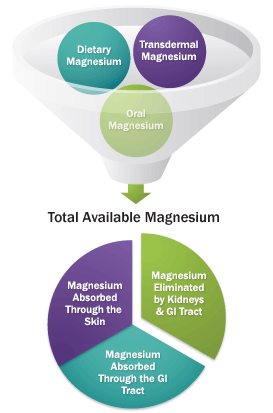Magnesium is an essential mineral for staying healthy and is required for more than 300 biochemical reactions in the body. Multiple health benefits of magnesium include transmission of nerve impulses, body temperature regulation, detoxification, energy production, and the formation of healthy bones and teeth. Magnesium is one of the six essential macro-minerals that comprise 99% of the body’s mineral content. It helps build bones, enables nerves to function, and is essential to the production of energy from food.
Magnesium has been shown to have therapeutic value in treating conditions such as headaches, chronic pain, asthma, and sleep disorders and in a recent large scale study, magnesium has been linked to a reduced incidence of conditions such as heart disease, hypertension and diabetes.
Every single cell in the human body demands adequate magnesium to function, or it will perish. Strong bones and teeth, balanced hormones, a healthy nervous and cardiovascular system, well- functioning detoxification pathways and much more depend upon cellular magnesium. Soft tissue containing the highest concentrations of magnesium in the body include the brain and the heart—two organs that produce a large amount of electrical activity, and which can be especially vulnerable to magnesium insufficiency.
Fluoride in drinking water binds with magnesium, creating a nearly insoluble mineral compound that ends up deposited in the bones, where its brittleness increases the risk of fractures. Water, in fact, could be an excellent source of magnesium—if it comes from deep wells that have magnesium at their source. Urban sources of drinking water are usually from surface water, such as rivers and streams, which are low in magnesium. Even many bottled mineral waters are quite low in magnesium, or have a very high concentration of calcium, or both. Here are some of the things magnesium does:
It gives rigidity and flexibility to your bones (more important than calcium in many cases), increases bioavailability of calcium, regulates and normalizes blood pressure, prevents and reverses kidney stone formation, promotes restful sleep, helps prevent congestive heart failure, eases muscle cramps and spasms, lowers serum cholesterol levels and triglycerides, decreases insulin resistance, can prevent atherosclerosis and stroke, end cluster and migraine headaches, enhances circulation, relieves fibromyalgia and chronic pain, treats asthma and emphysema, helps make proteins, encourages proper elimination, prevents osteoporosis, proper Vitamin D absorption, protection from radiation, to aid weight loss, lessen or remove ADD or ADHD in children, in proper digestion of carbohydrates, emerging evidence is showing a preventative role in many cancers.
Some surveys have associated higher blood levels of magnesium with lower risk of coronary heart disease. In addition, some dietary surveys have suggested that a higher magnesium intake may reduce the risk of having a stroke. There is also evidence that low body stores of magnesium increase the risk of abnormal heart rhythms, which may increase the risk of complications after a heart attack. These studies suggest that consuming recommended amounts of magnesium may be beneficial to the cardiovascular system.
Are You Low in Magnesium?
Low magnesium levels are often diagnosed by symptoms alone as there is no blood test that detects low magnesium levels. The reason for this is that about 99% of the magnesium in your body is stored in your bones, muscles and soft tissue and only about 1 % is actually in your blood. Early signals of magnesium deficiency include: Appetite loss, headaches, nausea, tiredness and weakness. On- going or more severe magnesium deficiency can lead to more serious symptoms, such as numbness and tingling, cramps, seizures, behavioural changes, abnormal heart rhythm and coronary spasm.
The following symptoms can also point to low magnesium levels: Inability to sleep or insomnia, irritability, sensitivity to noise, mental disturbances, anxiety, depression or restlessness, muscle soreness or spasms, infertility or PMS, high levels of stress, headaches, heart “flutters” or palpitations, fatigue or unusual tiredness, coldness in extremities, fuzzy brain or difficulty concentrating, allergies and sensitivities, lack of appetite, back pain, body odour, bad short term memory, poor coordination, insulin resistance, carbohydrate cravings, constipation, frequent cavities or poor dental health, gut disorders, kidney stones, thyroid problems.
If you have more than one of the above symptoms and especially if you have more than five, it is highly likely that you could benefit from having more magnesium in your diet. Some conditions known to impact magnesium availability include: Individual variations in amount of stomach acid, commonly reduced in older adults, excessive use of alcohol, Crohn’s disease, celiac sprue, and any disorder of the digestive or intestinal function, kidney disorders, genetic magnesium absorption disorders, stress, surgery, and chronic disorders such as diabetes, diarrhea and vomiting.
How To Get Enough Magnesium
Unfortunately, magnesium is often not well absorbed by the digestive track, and is even more difficult to absorb if you are deficient or are low in vitamin D, have poor gut bacteria or suffer from a number of other conditions. On top of that, most foods are depleted of their natural magnesium levels and the water supply is lacking also. There are several ways to supplement, and a mixture of more than one type of magnesium supplementation seems to be most effective. It is important to start slow and work up, as high doses will not be completely absorbed at first and most will be wasted. There is also evidence that over half of all magnesium taken internally is not used and leaves the body as waste.
Leafy green vegetables, sea vegetables, kelp, and especially nettle are good dietary sources of magnesium, though if you are deficient it will be difficult to raise your levels enough through diet alone. One of the best food sources of magnesium is pumpkin seeds – of which a quarter cup contains almost 50% of the RDA of magnesium! I would suggest you go for the organic ones – typically darker in colour because of their higher mineral content. Note that calcium and magnesium also need to be balanced with vitamin D3 and vitamin K2. In other words, any time you’re taking any of magnesium, calcium, vitamin D3, or vitamin K2, you need to take all four into consideration, since they all work synergistically.
Disorders linked with Magnesium deficiency
The following disorders have been linked with moderate to severe magnesium deficiency:
• Migraine headaches
• Type 2 Diabetes
• Osteoporosis
• Hypertension
• Atherosclerotic vascular disease, also commonly known as hardening of the arteries
• Colon cancer
• Asthma
Since all living life forms need magnesium to survive, fruits and vegetables usually have an abundance of it if grown organically in good soil. Levels of magnesium in crops can vary depending on how they were grown, since deficiency in the soil can cause poor magnesium uptake in produce. Asparagus, beets, beans, broccoli and cabbage are vegetables rich in magnesium. Apricots, bananas, pitted cherries, grapefruits, and oranges also have high magnesium content. You can also add dry almonds and Brazil nuts, cashews and roasted peanuts to salads for a magnesium-rich meal.
Magnesium deficiency is especially prevalent in older populations and is linked to insulin resistance, metabolic syndrome, coronary heart disease and osteoporosis. Several studies have confirmed the inverse relationship between magnesium intake and the risk of diabetes. For every 100mg/day increase in magnesium intake the risk of developing type 2 diabetes decreases by approximately 15%. Most magnesium intake in these studies was from dietary sources, not supplements. Clinical studies have shown improvement in insulin sensitivity with magnesium intake between 300 and 365 mg/day.
Researchers were also able to show that low magnesium levels resulted in impaired insulin secretion and lower insulin sensitivity. Since magnesium plays an important role in carbohydrate and glucose metabolism, it is no wonder magnesium status has an effect on diabetes. Magnesium is needed for the health of muscles, including the heart, and for the transmission of electrical signals in the body. Adequate magnesium intake has been associated with a lower risk of atherosclerosis and hypertension. More recently, several studies have found that a high intake of calcium without sufficient magnesium could increase the risk of arterial calcification and cardiovascular disease, as well as kidney stones.
Magnesium has a medium level of bioavailability – the degree to which a nutrient is absorbed and retained in the body for use. Magnesium is predominantly absorbed within the small intestine, with the efficiency of absorption depending on the amount of magnesium in the diet, the health of the gastrointestinal tract, the overall magnesium status of a person and their diet as a whole. On average about 20% to 50 % of ingested magnesium is absorbed. Unabsorbed magnesium is excreted in the faeces. These days there are different ways of getting magnesium into the body. Epsom salts baths are one way and applying magnesium topically, known as transdermal magnesium as it is applied to the skin either through lotions, gel, sprays or baths is another ways of getting magnesium into the system. Reports also suggest that using magnesium topically also benefits eczema and psoriasis.
Magnesium supplements are available, but it is best to obtain any vitamin or mineral through food, as this increases the likelihood of ingesting optimal levels of other required and beneficial nutrients. Many vitamins, minerals and phytonutrients work synergistically, i.e. their benefits for health when taken together are greater than simply their individual benefits. As such, it is recommended to focus on meeting daily requirements for magnesium from foods before resorting to supplements as a backup. If, however, you have decided to take a magnesium supplement the best forms are magnesium malate, magnesium carbonate, magnesium chloride and magnesium glycinate. These are all readily absorbed by your body.
The Recommended Daily Allowance (RDA) for magnesium depends on age and gender. The National Institutes of Health recommend that children 1-3 years of age get 80 milligrams of magnesium a day, rising to 130 mg for children aged 4-8, and then 240 mg for children aged 9-13. After age 14, RDA recommendations diverge for men and women, with men typically requiring more magnesium than women due to a larger average body mass. The RDA for males aged 14-18 is 410 mg and 360 mg is recommended for females aged 14-18. Adult females are advised to get 310-320 mg per day. An RDA of 350-400 mg is advised during pregnancy, and 310-360 mg when breastfeeding. The RDA of magnesium for adult males is 400-420 mg.
Disclaimer: The contents of this website are not intended to replace a one to one relationship with your health practitioner nor are they meant as medical advice. You are encouraged to do your own research and make your own decisions in partnership with your medical practitioner.
